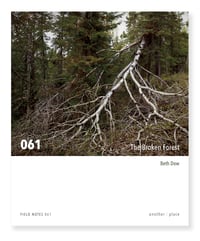FIELD NOTES 061
32 pp / 190 x 230mm
Staple Bound
Fedrigoni paper
First edition of 100
FN061
---------------------------------------------------------------------
There is no private grief in a forest. When a backyard tree dies, we quickly hide the mess of its failure, but when a tree dies in a forest it lingers, slowly dissolving back into nutrients. These are ordinary dramas of real life, where disease, injury, and death dwell among flickers of buds and rebirth. I walked into the boreal forest of Lake Superior’s North Shore and Gunflint Trail in early spring to study leafless trees. My plan was to make beautiful photographs, because beauty felt like a provocative and indulgent way to reset my vision.
I never expected this to be so complicated. Along the North Shore it’s easy to see the fallen soldiers of dying birch trees, as their broken white trunks lean like the final fifth strokes of tally marks. I was curious about the ecology of this fragile landscape and was surprised at what I learned. Before Europeans settled the northern coastal forest of Minnesota, the land was dense with white pine, spruce, and cedar. These valuable trees were harvested by loggers in the 19th century in a rush to commodify natural resources. Fires in the 1920s and 1930s swept through the slash left in the wake of logging, clearing out what was left. Grasses and paper birch thrived on this freshly cleared land, but these trees have a short life span and shallow roots, leaving them vulnerable to warming soil temperatures and the fierce winds that batter the Lake Superior shore.
A typical forest regenerates itself through new seedlings that will one day mature. Here, this natural cycle was disrupted by a flourishing and uncontrolled deer population. In winter, hungry deer are attracted to the warmer climate along the coast, where they browse young conifer trees and seedlings before they get the chance to establish new forest generations. What we see now are crumbling, ghost-like birch trees in a landscape struggling to find equilibrium.
Climate change is rapidly altering this forest ecology, and the trees are signals that systems are breaking. As I make these photographs I’m aware of the conflict between this stressed landscape and my odd, selfish thrill at the formal structures and textures of fallen trees. The tension between aesthetic and perceptive experience and bleak reality drives my work, and my goal is to make beautiful photographs that invite the viewer to pause as they consider what we have, and what we have to lose.
The Broken Forest was shot in Minnesota along the Gunflint Trail and the North Shore of Lake Superior, beginning in 2019.
---------------------------------------------------------------------
FIELD NOTES is a series of affordable zines showcasing photography projects which explore our relationship with 'place'.




